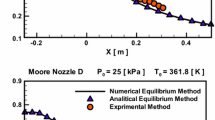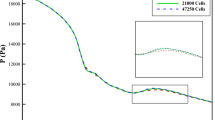Abstract
A two-fluid model with the influence of inter-phase velocity-slip taken into account is proposed and a modified realizable k–ε turbulence model is put forward as well to make the equation set of two-fluid model closed. Based on this two-fluid model, numerical simulations are implemented on typical wet steam flow in different cases. Good consistency between numerical result and the experimental result implies that this two-fluid model is provided with high accuracy and wide applicability. The flow field analysis also shows that there exist several particular sites along the flow direction. These particular sites could illustrate the development mechanism of nucleation and droplet growing. In addition, further discussion about the flow in cascade then indicates that the presence of condensation has strong impact on the flow while the impact of inter-phase velocity-slip is relatively weaker. The composition of total pressure loss is present here, the majority of total pressure loss brought by condensation is about 8.78 % of inlet total pressure while the inter-phase velocity-slip just results in a small part of about 0.42 % of inlet total pressure, the rest of the total pressure loss is caused by pneumatic factors and this part is about 3.95 % of inlet total pressure.



















Similar content being viewed by others
Abbreviations
- I :
-
Nucleation rate (kg−1 s−1)
- θ :
-
Non-isothermal correction factor
- σ :
-
Surface tension (N m−1)
- q c :
-
Condensation coefficient
- K b :
-
Boltzmann’s constant (J K)
- M m :
-
Mass of one water molecule (g mol−1)
- γ :
-
The specific heat ratio
- R :
-
Gas constant (J mol−1 K−1)
- \(r^{*}\) :
-
Critical radius (m)
- Kn :
-
Knudsen number
- T g :
-
Temperature of the ambient vapor (K)
- ξ :
-
Molecule fraction of condensation
- p d :
-
Hypothetical ambient pressure (Pa)
- r :
-
Drop radius (m)
- ρ g :
-
Gas phase conditions of density (kg m−3)
- ρ l :
-
Liquid phase conditions of density (kg m−3)
- u i :
-
i-Wise component of velocity (m s−1)
- p eff :
-
Effective pressure (Pa)
- g i :
-
i-Wise component of acceleration of gravity (m s−2)
- e :
-
Total energy per unit mass (J kg−1)
- λ eff :
-
Effective heat conductivity (W m−2 k−1)
- T g :
-
Temperature for gas phase (K)
- μ g :
-
Dynamic viscosity for gas phase (N s m−2)
- μ t :
-
Eddy viscosity for gas phase
- δ ij :
-
Kronecker symbol
- P rt :
-
Turbulent Prandtl number
- S m :
-
Source term for mass exchange (kg m−3)
- S u :
-
Source term for momentum exchange (kg m−2 s−1)
- S e :
-
Source term for energy exchange (J m−3)
- G :
-
Cunningham correction factor
- ρ m :
-
Local average density of mixed phase (kg m−3)
- u pi :
-
i-Wise component of droplet velocity (m s−1)
- Y :
-
Wetness fraction in mixture
- μ p :
-
Eddy viscosity for liquid phase
- N :
-
Droplet concentration (kg−1)
- B(T g ):
-
Second order virial coefficient
- C(T g ):
-
Third order virial coefficient
- k :
-
Turbulent kinetic energy (m2 s−2)
- ε(ε ijk ):
-
Turbulent dissipation rate (m2 s−3)
- h fg :
-
Latent heat of vaporization (J mol−1)
- τ rp :
-
Particle drag coefficient
- Re p :
-
Relative Reynolds number
- ΔT :
-
Degree of supercooling (K)
- Ma :
-
Mach number
- p :
-
Local static pressure for gas phase (Pa)
- p 01 :
-
Inlet total pressure (Pa)
- p 02 :
-
Outlet total pressure (Pa)
- λ g :
-
Heat conductivity (W m−2 k−1)
- h t :
-
Total enthalpy of gaseous phase (J kg−1)
- C p g :
-
Specific heat at constant pressure (J kg−1 k−1)
- C vg :
-
Specific heat at constant pressure (J kg−1 k−1)
- h g :
-
Specific enthalpy (J kg−1)
- s g :
-
Specific entropy (J kg−1 K−1)
- T d :
-
Droplet temperature (K)
- p s :
-
Flat-film saturation pressure (Pa)
- T s :
-
Saturation pressure (K)
References
Baumann K (1912) Recent developments in steam turbine practice. J Inst Electr Eng 48:830
Hill PG (1966) Condensation of water vapor during supersonic expansion in nozzles. J Fluid Mech 25:593–620
Guha A, Young JB (1991) Time-marching prediction of unsteady condensation phenomena due to supercritical heat addition. Inst Mech Eng Conf Publ C423/057:167–177
Crowe CT, Sharma MP, Stock DE (1977) The particle-source-in cell (PSI-CELL) model for gas-droplet flows. J Fluid Eng 6:325–332
Dykas S, Wróblewski W (2011) Single- and two-fluid models for steam condensing flow modeling. Int J Multiph Flow 37:1245–1253
Gosman AD, Ioannides E (1981) Aspect of computer simulation of liquid fuelled combustion. In: AIAA 19th aerospace science meeting, pp 1285–1293
Ishii M, Mishima K (1984) Two-fluid model and hydrodynamic constitutive relation. Nucl Eng Des 82:107–126
Dykas S, Wróblewski W (2013) Two-fluid model for prediction of wet steam transonic flow. Int J Heat Mass Transf 60:88–94
Bakhtar F, Mohammandi TMT (1980) An investigation of the two dimensional flows of nucleating and wet steam by the time marching method. Int J Heat Fluid Flow 2(1):5–8
Bakhtar F, Mamat ZA, Jadayel OC, Mahpeykar MR (2009) On the Performance of a cascade of improved turbine nozzle blade in nucleating steam, Part 1: surface pressure distribution. Proc Inst Mech Eng C223:1903–1914
Bakhtar F, Mamat ZA, Jadayel OC (2009) On the performance of a cascade of improved turbine nozzle blade in nucleating steam, Part 2: wake traverse. Proc Inst Mech Eng C223:1915–1928
Li L, Feng ZP, Li GJ (2001) Numerical simulation of two phase wet steam transonic flow with spontaneous condensation in a l-D nozzle. J Eng Thermophys 22(6):703–705
Ou GW, Shen MY (1986) The numerical simulation of non-equilibrium two phase wet steam transonic flow. Acta Aerodyn Sin 4(3):298–305
Zhang DY, Jiang HD, Liu JJ (2001) Numerical calculation of one dimensional steam nucleating flow by considering some influences. J Eng Thermophys 22(s1):26–28
Zhou LX (2011) Second-order moment modeling of dispersed two-phase turbulence, Part 1: USM, k–ε–k p , and non-linear k–ε–k p two-phase turbulence models. Sci China Phys Mech Astron 54(6):1098–1107
Kim SE, Choudhury D, Patel B (1997) Computations of complex turbulent flows using the commercial code ANSYS FLUENT. In: Proceedings of the ICASE/LaRC/AFOSR symposium on modeling complex turbulent flows, Hampton, Virginia
Shih TH, Liou WW, Shabbir A, Yang Z, Zhu J (1995) A new-Eddy-viscosity model for high reynolds number turbulent flows-model development and validation. Comput Fluids 24(3):227–238
Wang XD, Dong JL (2010) Numerical study on the performances of steam-jet vacuum pump at different operating conditions. Vacuum 84:1341–1346
Wang XD, Dong JL, Wang T, Tu JY (2012) Numerical analysis of spontaneously condensing phenomena in nozzle of steam-jet vacuum pump. Vacuum 86:861–866
Simpson DA, White AJ (2005) Viscous and unsteady flow calculations of condensing steam in nozzles. Int J Heat Fluid Flow 26:71–79
Wang XD, Lei HJ, Dong JL, Tu JY (2012) The spontaneously condensing phenomena in a steam jet pump and its influence on the numerical simulation accuracy. Int J Heat Mass Transf 55:4682–4687
Cai YN, Wang NN (1985) Two phase wet stream flow, vol 3. Xi’an Jiaotong University Press, Xi’an, pp 75–76
Jin QZ (1987) Numerical solution to the Navier–Stokes equations and turbulence models, vol 3. Hohai University Press, Nanjing, pp 28–29
Wu XM, Li L, Li GJ (2007) Three-dimensional numerical simulation of wet steam condensation flows based on a dual fluid model. J Eng Therm Energy Power 2(4):367–370
Zhou LX (1991) Theory and numerical modeling of turbulent gas-particle flows and combustion, vol 3. Tsinghua University Press, Beijing, pp 55–57
Young JB (1988) An equation of status for steam for turbo-machinery and other flow calculations. Trans ASME J Eng Gas Turbine Power 110(1):1–7
Zhang SJ, Li XH, Zhu BL, Hu QB (2009) Applicability of k–ε eddy viscosity turbulence models on numerical simulation of centrifugal pump. J Mech Eng 45(4):238–242
Moses CA, Stein GD (1978) On the growth of steam droplets formed in a Laval nozzle using both static pressure and light scattering measurements. J Fluids Eng 100:311–321
Li L (2002) Numerical study on the nonequilibrium wet steam two-phase flows with spontaneous condensation. Submitted in partial fulfillment of the requirements for the degree of Doctor of Philosophy. Xi’an Jiaotong University, Xi’an
White AJ, Young JB, Walters PT (1996) Experimental validation of condensing flow theory for a stationary cascade of steam turbine blades. Philos Trans R Soc Ser A 354:59–88
Acknowledgments
The authors are very grateful to Doctor Liu Huaping in HIT for his very helpful guidance. Besides, the research presented in this article is funded by the Research Groups of the National Natural Science Foundation of China (Grant No. 51121004) as well as the National Natural Foundation of China (Grant No. 50976026).
Author information
Authors and Affiliations
Corresponding author
Rights and permissions
About this article
Cite this article
Cui, K., Song, YP., Chen, HL. et al. Numerical investigation and quantitative loss analysis of typical wet steam spontaneous condensation based on two-fluid model. Heat Mass Transfer 52, 1329–1342 (2016). https://doi.org/10.1007/s00231-015-1657-5
Received:
Accepted:
Published:
Issue Date:
DOI: https://doi.org/10.1007/s00231-015-1657-5




